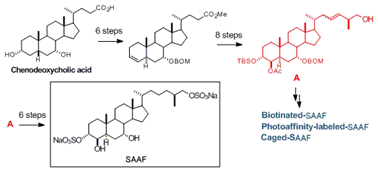Research Project
GENERAL
Our motto is:
"To achieve something that no one has ever done or even attempted"
We are looking at small exogenous molecules such as natural products that possess unique biological activities by means of NMR spectroscopy and synthetic organic chemistry.
We are also interested in endogenous small molecules such as lipids, sterols and peptides that form self-assemblies in membrane.
MEMBRANE MOLECULE
1、Amphotericin B
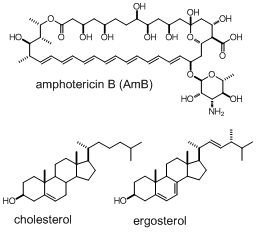 Amphotericin B (AmB) is a polyene antibiotic that has been used for treatment of systemic fungal infections for more than 30 years. AmB forms trans-membrane ion-permeable channels, which are thought to be responsible for its pharmacological activity. Its selective toxicity to fungi is explained by its higher affinity to ergosterol over cholesterol. It is presently widely assumed that AmB molecules in lipid bilayers form barrel-stave channels, with their polyhydroxy side pointing inward and their lipophilic heptaene part directing outward. However, although many investigations on the channel structure have been carried out, details of the structures, as well as molecular interactions in the channel, are not fully understood.
Amphotericin B (AmB) is a polyene antibiotic that has been used for treatment of systemic fungal infections for more than 30 years. AmB forms trans-membrane ion-permeable channels, which are thought to be responsible for its pharmacological activity. Its selective toxicity to fungi is explained by its higher affinity to ergosterol over cholesterol. It is presently widely assumed that AmB molecules in lipid bilayers form barrel-stave channels, with their polyhydroxy side pointing inward and their lipophilic heptaene part directing outward. However, although many investigations on the channel structure have been carried out, details of the structures, as well as molecular interactions in the channel, are not fully understood.
To reveal the structure of AmB channel complex, we prepared AmB and ergosterol labeled with 19F, 13C or 2H, and measured solid state NMR of those compounds in membrane. As a result, we successfully observed not only dynamics of those labeled compounds in membrane, but also distances of AmB-AmB and AmB-ergosterol. The accumulation of such information will give us detailed channel structure, which is expected to lead a development of new drag which has less side-effect.
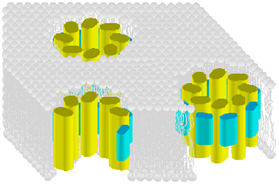
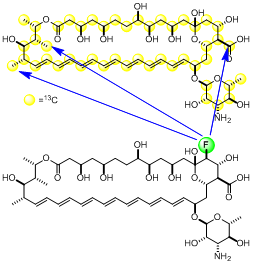
Barrel-stave model Intermolecular distance measurement
using 13C- and 19F-AmB
2、Lipid rafts
Although plasma membranes were once considered as a two-dimensional liquid where lipid molecules and proteins diffuse easily, their heterogeneity and complexity have been recently recognized. Particularly, it was found that sphingomyelin, the most abundant sphingolipid in biomembranes, form microdomains called lipid rafts on the plama membrane with cholesterol. Lipid rafts are believed to be responsible for a number of cellular processes including signal transduction, protein sorting and cholesterol shuttling. In addition, they are recognized as potential sites for toxin interactions, entryways for pathogens, and fusion sites of HIV. In spite of such biological significance, the way in which lipid rafts self-assemble and organize to a nanometer scale is still far from understood. To reveal the molecular recognition in lipid rafts as well as the mechanism of raft formation, we prepared 13C,19F, or 2H-labeled sphingomyelin and cholesterol, and measured solid-state NMR. As a result, we successfully obtained valuable information on their dynamics, orientation and molecular interactions in lipid rafts. Now we start molecular dynamics simulation based on the information obtained from NMR. In addition, for the analysis of molecular recognition between sphingomyelin and raft-integrated proteins, we are synthesizing fluorescent- and photoaffinity-labeled sphingomyelins. Gangliosides, glycosphingolipids having acidic nine carbon sugar sialic acid, are also the key players in lipid raft. Gangliosides play key roles in biological events including cell adhesion, cell-cell interaction, and infections of pathogenic bacteria as well as viruses. We focus on the motion and structure of the gangliosides in lipid raft, and going to study using NMR.
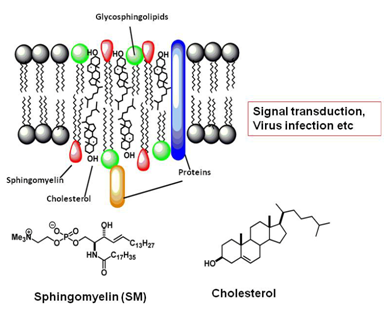
3. Bicelles
Recently, bicelles (a name derived from bilayered micelles), have been shown to provide a more natural membrane environments than micelles. Bicelles are generally composed of long-chain phospholipid such as DMPC and short-chain one such as DHPC, and adopt disk-shaped morphologies, in which the bilayer region formed by the long-chain lipid is surrounded by a rim of the short-chain lipid. And bicelle size is controllable by the ration DMPC/DHPC. When the ratio is over 3, bicelles are large and magnetically oriented. If the ration is less than 1, small and isotropic bicelles are formed, which allow high resolution liquid NMR measurements. Hence, we incorporated membrane-interacting compounds such as salinomycin and amphidinol into isotropic bicelles, and measured conventional liquid NMR. As a result, we determined those conformations in membrane environment, and proposed their mode of actions in membrane. Recently we have found that bicelles can reproduce lipid raft, and succeeded in conformation analysis of sphingomyelin in bicelles. Now we are challenging crystallization of membrane peptides and proteins using bicelle system in collaboration with ERATO group.
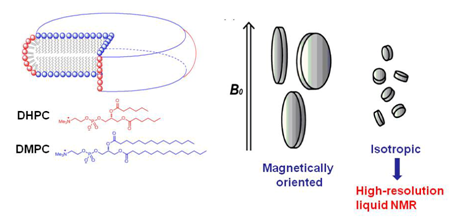
Schematic model of bicelles.
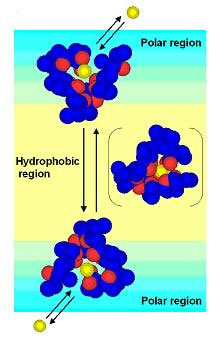
Proposed mechanism of cation transportation across membrane by salinomycin
4、 Amphidinol
Amphidinols (AMs) have been isolated as potent antifungal agents from the dinoflagellate Amphidinium klebsii. Among those, amphidinol 3 (AM3), whose absolute configuration was determined by our group, has the most potent antifungal and hemolytic activities. Their structures are characterized by long carbon chains encompassing multiple hydroxyl groups and polyolefins, which endow amphiphilic nature to the molecules. AMs enhance the permeability of the biological membrane by direct interaction with the membrane lipids, which is thought to be responsible for their potent antifungal activity. We found that AM3 forms toroidal-pore in membrane, and determined its conformation and location using micelles and isotropic bicelles. Recently we revised stereochemistry of AM3 by synthesizing partial structure of AM3 in collaboration with Prof. Oishi, Kyusyu University. Now we are trying to obtain large amount of AM3 from large scale culture in collaboration with Prof. Tsuda, Kochi University, in order to observe interaction between AM3 and cholesterol using solid state NMR.
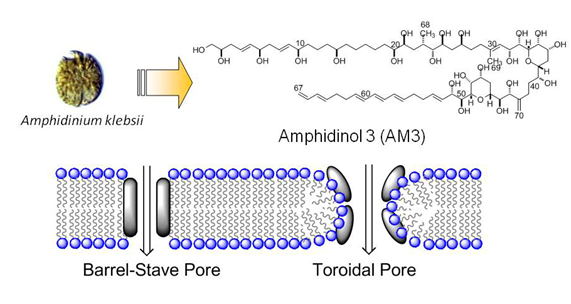
SYNTHESIS OF NATURAL PRODUCTS
1、Synthesis of bafilomycin A1
Vacuolar-type ATPases (V-ATPases) are ubiquitous proton pumps that are present in the endomembrane system of all eukaryotic cells and in plasma membranes of various animal cells. They have diverse functions, such as regulating the intracellular or intraorganellar pH, and are also correlated to an increasing number of diseases notably osteoporosis. Bafilomycin, which is a representative V-ATPase inhibitor, is widely used as a tool molecule to identify the physiological functions of V-ATPase. However, its detailed inhibitory mechanism is still unclear. In our laboratory, for the purpose of analyzing the V-ATPase-bafilomycin interaction by solid-state NMR, we undertook the synthesis of 19F and 13C labeled-bafilomycin.
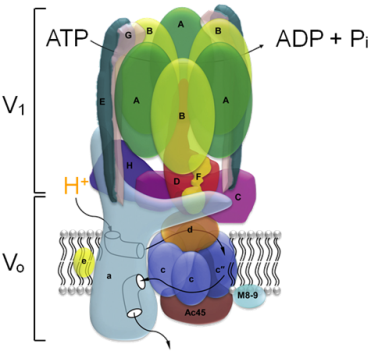
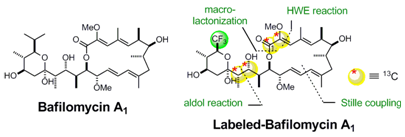
2、Total synthesis of spirolide C
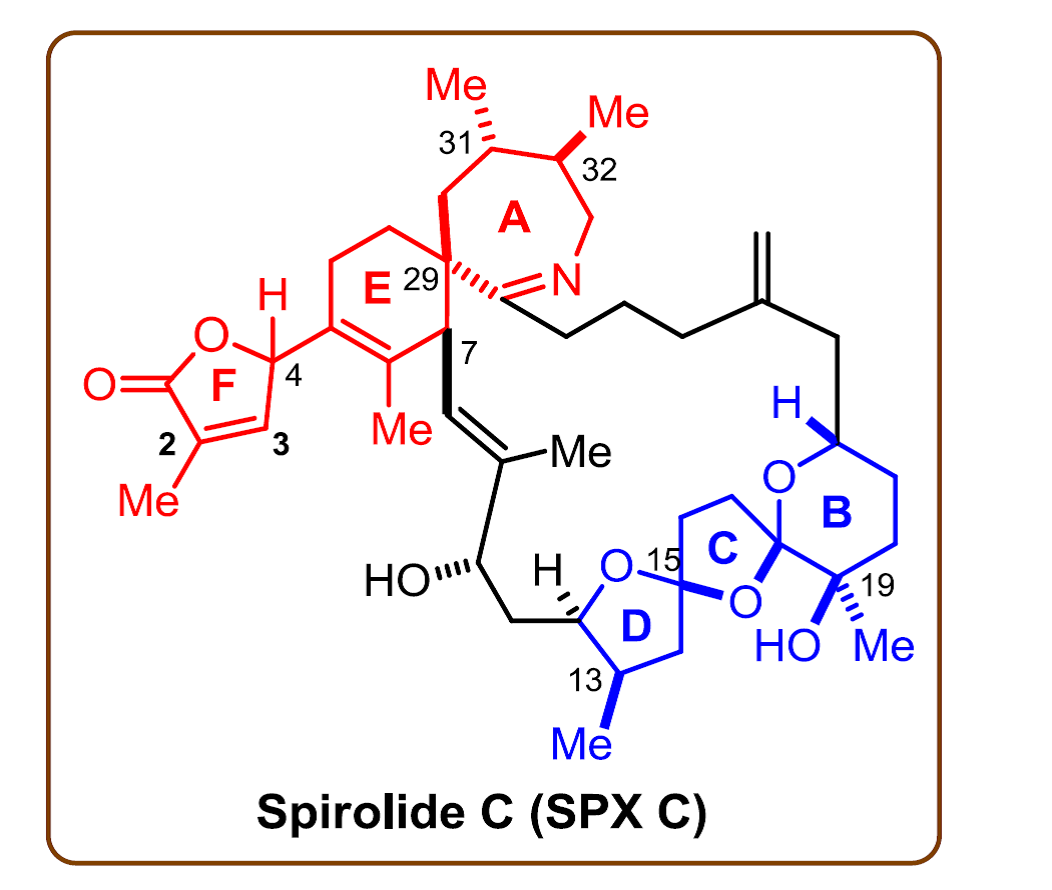 Spirolide C, one of the marine toxins with spiroimine rings, causes potent rapid-neurotoxic-mortality in mice by binding to the acetylcholine receptor. However, not only its mode of action but also its absolute configuration remains unknown. Especially even the relative configuration at the C4 position is ambiguous. One of the main reasons for this problem is thought to result from the structural complexity and flexibility of spirolide C. The spirolide C skeleton includes a 7,6-spiroimine unit (A,E rings) with an unstable γ-butenolide (F-ring) and a 6,5,5-bisspiroketal unit (B,C,D rings) connected with each other through an acyclic bridge of four or five carbon bonds. In our research, the complete structural elucidation of spirolide C by its total synthesis is now ongoing. It will lead to further studies to understand its biological activity.
Spirolide C, one of the marine toxins with spiroimine rings, causes potent rapid-neurotoxic-mortality in mice by binding to the acetylcholine receptor. However, not only its mode of action but also its absolute configuration remains unknown. Especially even the relative configuration at the C4 position is ambiguous. One of the main reasons for this problem is thought to result from the structural complexity and flexibility of spirolide C. The spirolide C skeleton includes a 7,6-spiroimine unit (A,E rings) with an unstable γ-butenolide (F-ring) and a 6,5,5-bisspiroketal unit (B,C,D rings) connected with each other through an acyclic bridge of four or five carbon bonds. In our research, the complete structural elucidation of spirolide C by its total synthesis is now ongoing. It will lead to further studies to understand its biological activity.
3、Synthesis of KRN7000 (α-galactosyl ceramide)
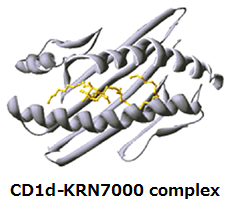 KRN7000, a potent antitumor glycosphingolipid known as ?-galactosylceramide, was developed through the structural modification of the natural product (agelasphins) isolated from a marine sponge. KRN7000 interacts with the antigen-presenting CD1d expressing on immune cells, and stimulates cytokine productions through forming a ternary complex with the specific T-cell receptor on natural killer T-cells. The successful X-ray structural analysis of CD1d complexed with KRN7000 encourages a lot of synthetic efforts to develop more potent drugs. However, ideal drugs are not on the market, so far. It is considered that the poor electron density of the ligand prevents efficient drug design. Therefore, we develop a novel strategy to overcome the issue by synthesizing heavy atom labeled KRN7000.
KRN7000, a potent antitumor glycosphingolipid known as ?-galactosylceramide, was developed through the structural modification of the natural product (agelasphins) isolated from a marine sponge. KRN7000 interacts with the antigen-presenting CD1d expressing on immune cells, and stimulates cytokine productions through forming a ternary complex with the specific T-cell receptor on natural killer T-cells. The successful X-ray structural analysis of CD1d complexed with KRN7000 encourages a lot of synthetic efforts to develop more potent drugs. However, ideal drugs are not on the market, so far. It is considered that the poor electron density of the ligand prevents efficient drug design. Therefore, we develop a novel strategy to overcome the issue by synthesizing heavy atom labeled KRN7000.

4、Synthesis of Ascidian Sperm-Activating and Attracting Factor (SAAF)
During fertilization, sperms are activated and attracted toward egg by a substance released from egg, which is a crucial event for species conservation, particularly for animals living in aquatic environments. Recently, we have isolated a non-peptidic compound (only 4 μg !) from the eggs of ascidian Ciona intestinalis, which possesses both sperm activation and attraction, named sperm-activating and attracting factor.(SAAF) After our successful structural estimation of SAAF from NMR and MS experiments, we completely have confirmed its proposed structure by the chemical synthesis, which also led to its sufficient supply. Currently, in order to reveal the molecular mechanism of SAAF, the synthesis of various labeled-derivatives such as biotinated-, photoaffinity-labeled- and caged-SAAF are undergoing from the common intermediate A.
